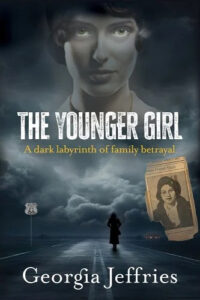On March 2, 1933 Chicago tabloids trumpeted the shocking downstate death of Aldine Younger. Aging dirty blonde newsprint scotch-taped to cardboard was my formal introduction to my father’s beloved 20 year old sister. He was still a child when her broken body was abandoned on a frozen back road in Pontiac, Illinois. The newspapers’ big block letters floated above a photograph of a beautiful young woman:
“HEIRESS SLAIN…BODY FOUND IN ROAD AFTER DRINKING PARTY…MARRIED MAN HELD”
When Aldine posed for her last picture, she had no idea it would be presented for public consumption on city streets and delivered into the private mailboxes of strangers. And yet, seemingly ready for her close-up, she had dressed to beat the band. Fur coat, silk scarf, sleek cloche hugging her bobbed shiny waves.
lt was the expression behind the good looks and elegant attire that held me. Her mouth, full and lipsticked, curved in a knowing half-smile. Her bright-eyed gaze was clear and direct. Nothing tentative about her presence. Look at me, she said. Look at me. I did. In fact I felt powerless to tear my eyes away.
My mother found me pouring over the scant details under the headlines: the girl‘s body found by a passing motorist, the arrest of 39 year old Asher Bentley at the residence shared with his wife and father, the former mayor of Pontiac… I was a good reader, the best in my fourth grade class, and I read fast. But not fast enough. My mother pulled the old box of family mementoes from my hand and closed the lid.
That was your Aunt Aldine, she told me.
I knew her name, but not her history.
Every Memorial Day my parents made the two hour trek from our suburban home in Peoria, Illinois north to Pontiac and Fairbury, small farming towns nestled between cornfields and prairie windmills. The purpose was always the same. Place fresh gladiolas on the tombstones of my dad’s mother and grandparents then travel to a separate cemetery to pay respects to my dad’s sister. The girl who died in an “accident” decades before I was born.
Let’s put these away before your father comes home. It’s almost time for supper, she said.
Any child knows when an adult changes the subject, there’s something forbidden in the air. Secrets to be revealed. In the years to come I asked questions about the “accident” that was no accident. About the heiress who was penniless at her death because the fortune inherited from her wealthy father had been stolen. About the mayor’s son who was convicted by a jury of twelve men, then later exonerated by the Illinois Supreme Court because of a so-called technicality.
The most I could glean — and this only after my father had a few beers to loosen his tongue and ponder the hardships of his youth — was a jumbled litany of injustice. Bentley killed Aldine because “she wouldn’t give him what he wanted”. Bentley’s father “bought off” the judges that freed his son. And most horrifying, Bentley had been hired by the rich uncle who stole Aldine’s trust fund to silence his outraged niece. I had met that great-uncle, a pink-cheeked old man who kept hard candies in his pocket for well-behaved children.
Don’t think blood won’t kill blood, Dad said, look at Cain and Abel.
By this time our family had moved to California to make “a new start“. My mother loved the Golden State but died too soon. I graduated from UCLA and became a storyteller (as my young daughter called my screenwriting career). My father, however, did not thrive. He yearned for his Midwestern roots and with every year sank deeper into despair.
Then one spring morning I heard from a distant cousin about an upcoming family reunion of my paternal grandmother‘s clan. I asked my dad to go back home with me.
No. Too expensive.
I‘ll pay for everything.
No. Too many bad memories.
I was thinking…
My father glared at me.
…I might write a story about you and your sister. The farm where you grew up, the sidewalk where she taught you to roller skate–
No. I’m too tenderhearted to deal with all that.
This is for Aldine.
During the two.weeks we spent in the hot humid Illinois summer of 1996, I learned that my dad’s sister had not endeared herself to everyone.
Like a flawed diamond with murky facets, her memory sparked conflicting opinions. My dad’s brother confided that she was “no angel”. A cousin Iamented the “shame and scandal” her roadhouse carousing with a man twice her age brought to the family. But a school classmate remembered only Aldine’s generosity, the gift of a necklace that this now 80 year old woman still owned and cherished. One old farmer clucked his tongue and grinned, “Nobody in these parts had ever seen anything like her”. What surprised me was that sixty-three years after her death, her name was known, “the accident” remembered. Aldine Younger was still stirring up passion and dissent in her hometown.
Shortly after our pilgrimage to his childhood home, my father’s heart stopped beating. The doctors said it happened fast.
In the years that followed I returned to Illinois to finish what we had begun together. I visited the courthouse in Pontiac, discovered a trail of damning property records and waded through a labyrinthine stack of documents in the law offices of my grandmother’s personal attorney. Follow the money, follow the money…
For all the factual evidence that fueled my journey, I knew that the “true” story of Aldine Younger could only be told through fiction. What began as an accounting of a girl’s life and violent death transformed into a bigger story. A Midwestern noir about a family struggling to escape the sins of greed and betrayal. The bridge between generations, past and present, became my literary playing field.
Subjects choose their authors as much as we choose them.
***


















